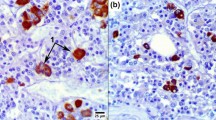Summary
Pituitary autografts placed under the renal capsule of adult female rats in estrus were found to produce luteotrophin. Indirect evidence indicates that autografts in male and female rats which were operated on at puberty probably produce this hormone also. Studies on both the adult and “pubertal” animals indicate that pituitary autografts produce the other anterior lobe hormones either at a very low level or not at all.
The predominant chromophilic cell type in grafts known to be producing luteotrophin is an elongated acidophile staining selectively with orange G when the “azan” stain is used. Two types of acidophiles were found in the intact rat pituitary, one staining with azocarmine and the other with orange G. The latter has the same morphology as the predominant cell type in active autografts and is considered to be the source of luteotrophin in the rat.
Similar content being viewed by others
Bibliography
Callahan, W. P.: III. The morphology of the sebaceous type glands of the rat as influenced by certain hormonal factors. Ph. D. Diss., The University of Texas Medical Branch, 1958.
Dawson, A. B.: Some evidences of specific secretory activity of the anterior pituitary gland of the cat. Amer. J. Anat. 78, 347–409 (1946).
—: The demonstration by differential staining of two types of acidophiles in the anterior pituitary gland of the rat. Abstract. Anat. Rec. 120, 810 (1954).
Dawson, A. B., and H. B. Friedgood: Differentiation of two classes of acidophiles in the anterior pituitary of the female rabbit and cat. Stain Technol. 13, 17–21 (1938).
Desclin, L.: A propos du mecanisme d'action des oestrogènes sur le lobe antérieur le hypophyse chez le rat. Ann. Endocr. (Paris) 11, 656–659 (1950).
Everett, J. W.: Luteotrophic function of autografts of the rat hypophysis. Endocrinology 54, 685–690 (1954).
—: Functional corpora lutea maintained for months by autografts of rat hypophyses. Endocrinology 58, 786–796 (1956).
Fortier, C.: Studies on the control of ACTH release by means of hypophyseal transplants. Ciba Foundation Colloquia on Endocrinology, Vol. 4, pp. 124–138. New York: Blakiston Co. 1952.
Friedgood, H. B.: Neuro-endocrine and cyto-physiological aspects of adenohypophyseal function. The chemistry and physiology of hormones, pp. 202–209. Amer. Assoc. for the Advancement of Science, Washington, D. C. 1944.
Goldberg, R. C., and E. Knobil: Structure and function of intraocular hypophyseal grafts in the hypophysectomized male rat. Endocrinology 61, 742–752 (1957).
Harris, G. W., and D. Jacobsohn: Functional hypophyseal grafts. Ciba Foundation Colloquia on Endocrinology, Vol. 4, pp. 115–123. New York: Blakiston Co. 1952.
Holtkamp, D. E., S. Ochs, C. C. Pfeiffer and A. E. Heming: Determination of the oxygen consumption of groups of rats. Endocrinology 56, 93–104 (1955).
Lacour, F.: Recherches sur la relation entre les cellules hypophysaires à granulations orangées (cellules ɛ de Romeis) et les phénomèns de lactation. C. R. Soc. Biol. (Paris) 144, 248–249 (1950).
Meyer, R., K., and K. H. Clifton: Effect of diethylstilbestrol induced tumorigenesis on the secretory activity of the rat anterior pituitary gland. Endocrinology 58, 686–693 (1956).
Nikitovitch-Winer, M., and J. W. Everett: Comparative study of luteotrophin secretion by hypophysial autotransplants in the rat. Effects of site and stages of the estrus cycle. Endocrinology 62, 522–532 (1958).
Rennels, E. G.: Two tinctorial types of gonadotrophic cells in the rat hypophysis. Z. Zellforsch. 45, 464–471 (1957).
—: The dependence of hair maturation in the rat on luteotrophin. Abstract. Anat. Rec. 130, 363 (1958).
Roe, J. H., and C. A. Kuether: The determination of ascorbic acid in whole blood and urine through the 2,4-dinitro-phenylhydrazine derivative of dehydroascorbic acid. J. biol. Chem. 147, 398–407 (1943).
Smith, P. E.: Hypophysectomy and a replacement therapy in the rat. Amer. J. Anat. 45, 205–273 (1930).
Author information
Authors and Affiliations
Additional information
This study was supported by research grant R. G. 4723 from the U.S. Public Health Service.
Rights and permissions
About this article
Cite this article
Sanders, A.E., Rennels, E.G. Evidence on the cellular source of luteotrophin derived from a study of rat pituitary autografts. Z. Zellforsch. 49, 263–274 (1959). https://doi.org/10.1007/BF00334727
Received:
Issue Date:
DOI: https://doi.org/10.1007/BF00334727




